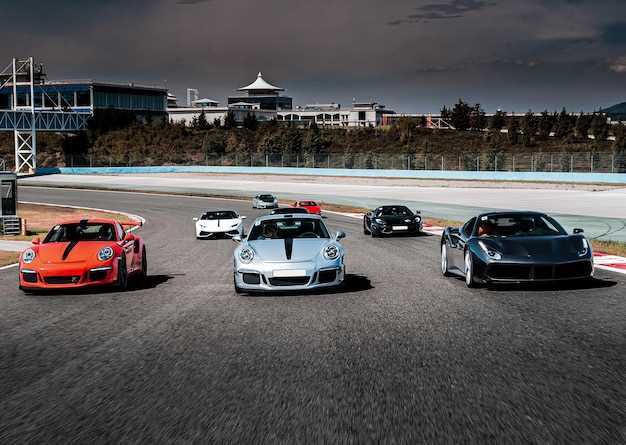For those who crave speed and performance, 2024 delivers some jaw-dropping supercars that push the limits of engineering. These remarkable vehicles not only showcase cutting-edge technology but also provide exhilarating driving experiences. If you’re on the hunt for the fastest models, you’ve come to the right place.
This year, the Bugatti Chiron Super Sport 300+ takes the lead, hitting an astonishing top speed of 304 mph. Its quad-turbocharged W16 engine delivers unmatched power, making it a clear frontrunner for speed enthusiasts. Following closely is the SSC Tuatara, which boasts a claimed speed of 286 mph. Its sleek design and lightweight construction amplify its performance on the track.
The Koenigsegg Jesko Absolut isn’t far behind, with impressive aerodynamics that enable it to reach approximately 330 mph in ideal conditions. This model exemplifies the perfect blend of artistry and technological prowess, captivating fans with every curve. Rounding out the list, the Aston Martin Valkyrie makes a striking entry, achieving a top speed of 250 mph while providing a unique blend of luxury and athleticism.
Each of these supercars stood out with distinct features and innovative designs that redefine performance standards. Whether it’s the blistering acceleration or aerodynamic efficiency, the supercars of 2024 are prime examples of what the future holds for speed enthusiasts.
Top Speed Figures of 2024 Supercars
The 2024 lineup of supercars presents extraordinary speed figures that captivate enthusiasts. Here are the top contenders based on their remarkable top speeds:
Bugatti Bolide – Impressively hits an astonishing speed of 310 mph, showcasing Bugatti’s relentless pursuit of performance.
Pininfarina Battista – This electric marvel reaches up to 217 mph, redefining electric vehicle capabilities with its sleek design and engineering prowess.
Aston Martin Valkyrie – With a top speed of 250 mph, the Valkyrie combines aerodynamic efficiency and a powerful V12 engine to deliver thrilling performance.
Mclaren Sabre – Achieving 218 mph, the Sabre merges cutting-edge technology with an elite supercar experience.
Koenigsegg Jesko Absolut – The manufacturer claims a staggering potential speed of 330 mph, pushing the boundaries of hypercar engineering yet again.
These figures reflect just a fraction of the cutting-edge technology and design philosophies driving supercars in 2024. Each model brings a unique approach to achieving ultimate speed. Whether it’s the electric prowess of the Battista or the mechanical excellence of the Valkyrie, these supercars highlight an exciting era in automotive innovation.
Comparing Acceleration Times of Leading Models
The acceleration times of the top supercars of 2024 reveal impressive performance metrics. The Porsche 918 Spyder achieves a remarkable 0 to 60 mph in just 2.2 seconds, showcasing its blend of hybrid technology and lightweight design. The Bugatti Chiron Super Sport follows closely, accomplishing the same sprint in 2.4 seconds, powered by its quad-turbocharged W16 engine.
Next, the Lamborghini Sián FKP 37 impresses with a 0 to 60 time of 2.5 seconds. Its hybrid powertrain not only enhances speed but also improves efficiency. Additionally, the McLaren Sabre boasts a commendable 0 to 60 in 2.6 seconds, leveraging advanced aerodynamics and a powerful V8 engine.
The Aston Martin Valhalla takes a distinctive approach, reaching 60 mph in 2.9 seconds. This model highlights a unique blend of luxury and performance, ensuring a thrilling experience. In comparison, the Ferrari SF90 Stradale manages this feat in 2.5 seconds, underlining Ferrari’s commitment to speed and innovation.
For those looking for a blend of performance and practicality, the Tesla Model S Plaid achieves 0 to 60 mph in a staggering 1.99 seconds, making it the fastest production car in acceleration. This electric vehicle sets a new standard in the supercar segment.
In summary, acceleration times among these leading models reflect cutting-edge technology and engineering excellence. Each car brings its unique strengths, making them worthy contenders in the race for supremacy in speed and acceleration.
Technological Innovations Driving Speed Innovations
Advanced aerodynamics play a key role in enhancing supercar performance. Manufacturers design sleek shapes and active aerodynamic features that adapt to driving conditions, helping reduce drag and increase downforce. Look for cars with adjustable wings and vents that optimize airflow for various speeds.
Lightweight materials significantly impact speed. Carbon fiber, titanium, and advanced alloys are now standard in supercar construction, reducing weight without compromising strength. Check specifications for weight-to-power ratios, as lighter cars often outperform heavier counterparts.
The integration of hybrid and electric powertrains offers a unique advantage in acceleration. Electric motors provide instantaneous torque, giving supercars a quick start off the line. Many 2024 models utilize a combination of traditional combustion engines and electric systems to achieve breathtaking speed. Consider brands that implement this technology for enhanced performance metrics.
Advanced tire technology is vital for maintaining grip at high speeds. Manufacturers invest in innovative rubber compounds and tread designs that provide better traction and handling. Pay attention to the type of tires fitted as they can significantly affect a car’s speed and reliability.
Next-generation suspension systems improve handling and stability. Active suspension setups utilize sensors and electronic control to adjust the stiffness in real-time, ensuring optimal contact with the road. Look for supercars offering customizable suspension settings to match individual driving preferences.
| Innovation | Benefit |
|---|---|
| Aerodynamics | Reduces drag, increases downforce |
| Lightweight Materials | Improves power-to-weight ratio |
| Hybrid/Electric Powertrains | Enhances acceleration with instant torque |
| Tire Technology | Increases grip and handling |
| Next-Gen Suspension | Improves stability and handling |
Embracing these technological innovations allows manufacturers to push the limits of speed. Each element works together to create supercars that not only perform well on paper but also deliver exhilarating driving experiences on the road or track.
Impact of Aerodynamics on Supercar Performance
A supercar’s speed and handling significantly rely on its aerodynamic design. Engineers focus on reducing drag and increasing downforce, optimizing performance at high velocities. A well-designed body shape channels airflow effectively, minimizing turbulence. Look for features like active aerodynamics that adjust to speed and driving conditions, enhancing grip and stability.
Downforce plays a critical role in maintaining tire contact with the road, especially during aggressive cornering. Spoilers, diffusers, and canards contribute to this effect by directing airflow to create pressure that pushes the car down. Supercars like the Bugatti Chiron and McLaren Sabre utilize advanced aerodynamic components to achieve superior high-speed handling.
Another aspect to consider is the balance between drag reduction and downforce generation. While reducing drag increases straight-line speed, too much emphasis on this can lead to instability at higher speeds. Manufacturers often employ wind tunnel testing and computational fluid dynamics (CFD) simulations to fine-tune designs.
Materials also impact aerodynamics. Lightweight composites lower the overall weight, allowing for better acceleration and braking. The improved shape, combined with lighter materials, enhances the overall performance envelope of a supercar.
Pay attention to cooling systems as well. Efficiently designed intakes and vents allow for optimal cooling without compromising aerodynamic efficiency. Supercars like the Ferrari SF90 Stradale exemplify this balance, allowing you to harness the full potential of your vehicle.
In summary, aerodynamics is not just about speed; it’s equally about control and stability. When selecting a supercar, consider how the aerodynamic features influence performance, ensuring a well-rounded driving experience.
Price vs. Performance: What You Get for Your Money
Investing in a supercar means evaluating speed alongside cost. The Bugatti Chiron Super Sport 300+, priced around $3.9 million, offers breathtaking top speeds of over 300 mph and top-tier craftsmanship. It justifies its high price with unparalleled engineering and exclusivity.
On a slightly lower budget, the Aston Martin Valkyrie comes in at about $3 million. Offering 1,160 hp from its hybrid V12 engine, it combines raw power with exceptional aerodynamics. While not as high-strung as the Chiron, the Valkyrie delivers stellar performance, making it a smart choice for enthusiasts prioritizing technology over sheer speed.
For a more accessible option, consider the McLaren Sabre, priced at around $3.5 million. With a remarkable 824 hp and a top speed nearing 218 mph, it provides exhilarating performance that rivals even pricier competitors. The focus here is on track capability rather than sheer straight-line speed.
If you’re seeking value, the Porsche 918 Spyder, at approximately $1 million, is hard to beat. This hybrid supercar achieves around 875 hp and has a top speed of 214 mph. Its combination of efficiency and performance makes it unique in the supercar segment.
Finally, the Ferrari SF90 Stradale, priced around $625,000, delivers impressive 986 hp and a top speed of 211 mph. The SF90 balances performance with usability, making it a versatile option for daily driving and track days alike.
Evaluating supercars by their price-to-performance ratio reveals that while some models may command higher prices, others deliver exceptional value without sacrificing thrills. Select wisely according to your performance needs and budget constraints.
Future Trends in Supercar Speed Development
Focus on electrification as the primary avenue for increasing supercar speed. Brands are shifting towards hybrid and fully electric powertrains, providing immense torque and instant acceleration. The Rimac Nevera exemplifies this with its impressive 0-60 mph sprint in just 1.85 seconds, showcasing electric motors’ potential.
Implement lightweight materials extensively in supercars. Manufacturers are integrating carbon fiber and graphene to reduce weight without sacrificing safety. This shift enhances performance ratios, allowing for higher speeds and better handling. The McLaren Sabre perfectly demonstrates this principle, balancing weight and power seamlessly.
Adopt advanced aerodynamics to optimize airflow. Active aerodynamics systems that adjust in real time significantly enhance downforce and stability at high speeds. The Mercedes-AMG One employs cutting-edge technology in its design, reflecting the benefits of such innovations in real-world performance.
Prioritize smart technology integration for real-time data analysis. Utilizing machine learning algorithms can enhance driving dynamics by providing customized performance adjustments based on road conditions and driver behavior. Brands like Aston Martin are beginning to explore these options in their development processes.
Consider implementing advanced tire technology for improved grip and durability. Manufacturers are developing tires that can withstand higher temperatures and provide better performance under various conditions. The Michelin Pilot Sport Cup 2, for example, offers exceptional grip for high-performance vehicles aiming for top speeds.
Explore hydrogen fuel cell technology, which presents an alternative to conventional powertrains. While in its infancy, the potential for high energy density and fast refueling makes it an exciting prospect for the future of supercar performance, with manufacturers like Toyota leading initial efforts.
Emphasize autonomous driving features that can enhance speed management and safety. Integration of AI-driven systems can allow supercars to achieve higher speeds in controlled environments while optimizing performance. The Tesla Roadster is paving the way with its focus on combining speed and technology.







